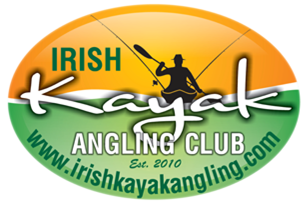Tim O’Herlihy completes his trilogy with a look towards getting to and from the water in safety... It's a great read!


A typical IKA meet!
If you have read Parts 1 & 2 you will realise that I’ve learned a lot since I first launched a kayak to fish. It has been an enjoyable learning curve for a sport that was pretty much alien to me to begin with. In the hope of saving you some time, I’ve tried to put important points here for you. Take it as an “incomplete beginners guide” as it is possible that I’ve missed something.
First things first!
If you already have fishing gear, spend every cent of your budget on your kayak, the gear that will keep you safe & the gear that will get you home if it all goes wrong.
If you don’t already have fishing gear, start off with inexpensive stuff. One rod, one reel – The rod needs to be long enough that you can get top of the rod over the bow (front) or stern (back) if the fish changes sides. 6 foot – 8 foot rods are ideal for this, any longer it can get cumbersome on board.
Buy a couple of packs of Sabiki Rigs by Shamrock Tackle – Euro Champ, Bleeding Gloworm, or my personal favourite New Euro Champ Rig. Cut them in half as more than 3 hooks will be too long to handle on the kayak. Add a few leads in different weights & you’re ready to begin.
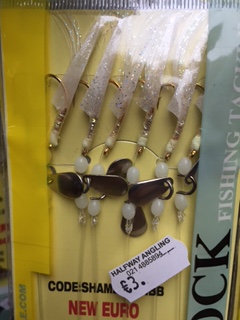
Tim’s Top Tip 🙂
Safety Items
I’m not going to name any particular brands as my gear is a mishmash of different manufactures. So, in no particular order (I don’t launch without these items):
Drysuit
It took me a long time to bite the bullet & get one due to the expense. It is one of those items that once you get it, you’ll never go back. No overheating in the sun, no getting cold as the water evaporates off it. Get one that is breathable, & preferable with a crotch zip also known as relief zip.
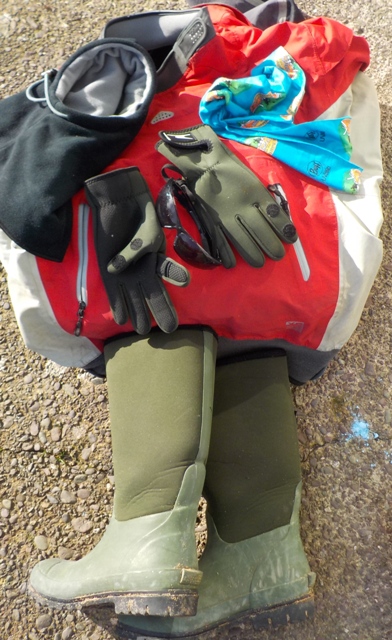
My essentials
Personal Flotation Device (PFD)
I started with a sailing buoyancy aid we had at home, moved to a kayaking PFD as the large collar on the sailing PFD was annoying when trying to look around. Eventually I bought a fishing PFD from another member of the club. It’s great, has pockets & eyes to tie & hold my PLB, VHF, Phone, Strobe, Camera etc.

My PFD, PLB, VHF, Strobe, Knife, GPS &
Phone. Emergency communication devices
need to be tied to you!
Handheld, Floating, VHF
Get to know the features and the range of whatever VHF (Very High Frequency) radio you choose & keep it tied onto you. Great for communicating with pretty much anyone else on the water, be it a fellow kayak angler, a ship or even the coastguard. These are limited in range and to line of sight only. Channel 16 is the Coastguard Channel.
(Note: Technically speaking you need to have a licence to operate a VHF radio. You also need a Ships Radio Licence to broadcast. A licence is then related to your “call sign” and you can input your MMSI Number (Maritime Mobile Service Identity) into your DSC (Digital Selective Calling) VHF radio. You will then be able to send out automatic distress signal if necessary. People use VHF every day without licences. However it is important to familiarise yourself with the correct procedures and etiquette.)
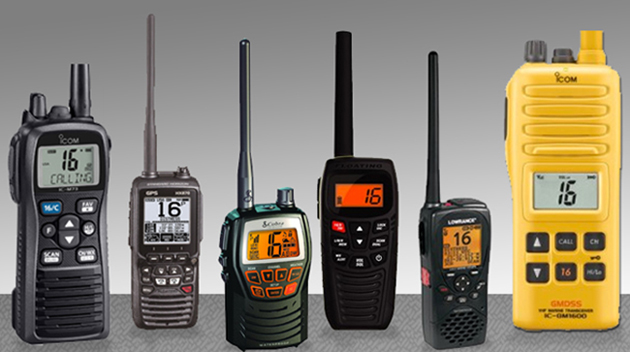
VHF is a must have!
Personal Locator Beacon – PLB
Register your unit with ComReg & add 3 emergency contact numbers. Simple to use, keep it tied onto you. Battery Life is 6 years, so while you can expect to pay in the region of €250, if you’re out 20 times in a year, that’s €2 a go! When activated a signal via satellite will give your position to 100m or less.
PFD Knife
You’ll have a knife for chopping bait but, if you end up in the water tangled in fishing/anchor/drogue lines, you might not be able to get at it to cut yourself free. So a knife located on your PFD is a comfort.
PFD Whistle
Costing €2 or less it may help to draw attention.
Compass/GPS
There is always a chance of fog on our coasts, & if you don’t have phone signal, how will you know which way is home?
First Aid Kit
Cut yourself while cutting bait, get scratched by a dog fish or cut/spiked by something else. If it’s bad, you’ll need to be able to seal it.
Waterproof Phone Pouch
Bringing your phone is no use unless you can use it when you’re in trouble. It won’t last long if you’re in the sea without protection. There are loads of options out there. If you have a touch screen, make sure you can use it through whatever pouch you pick.
Food & Water
Keeping yourself hydrated & your energy levels up can make the difference between getting home safe & calling for rescue.
Paddle Leash!
You’re not getting home if you lose your paddle!
Paddle Keeper
If your kayak doesn’t have one, try the Scotty version. Why? You’re paddle is out of the way, & locked in position. Otherwise it’s under you knee, on your lap, or behind your ear.
The Idiot flag
We’re low in the water & I don’t want to become a mobile speed bump to someone who isn’t paying attention. Buy one, or make your own from the flags you stick on car windows & display your club/county colours. Then again, maybe that would make the bump deliberate….
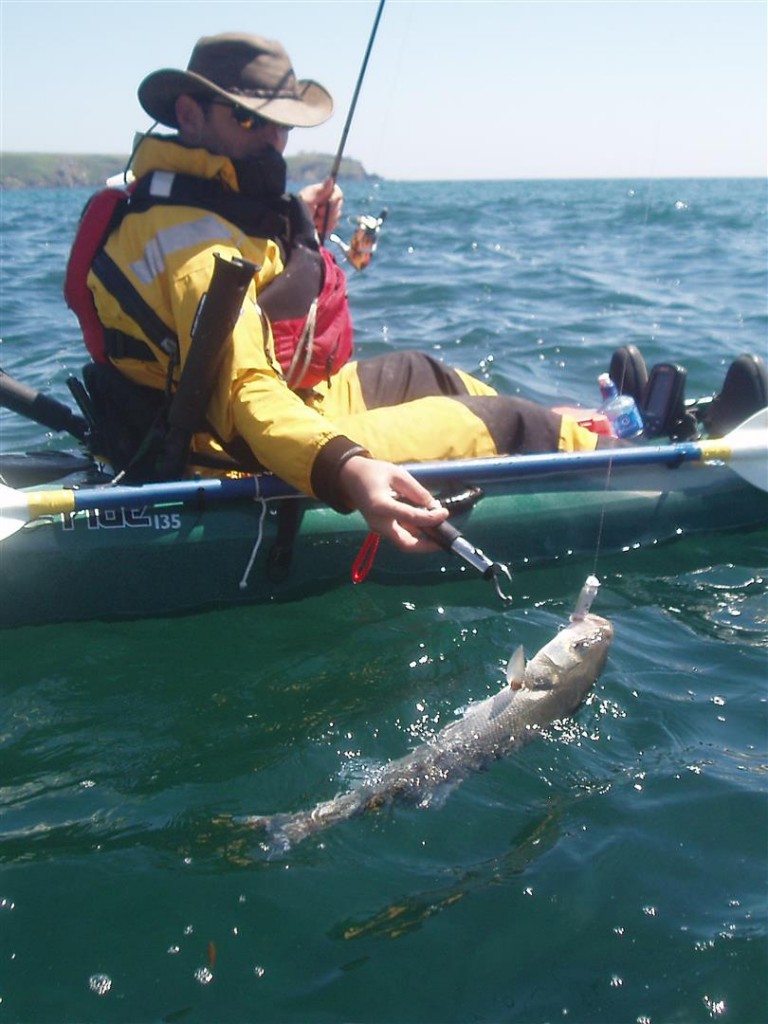
As close to the fish as you can get without swimming!
Torch & spare
The second time I stayed out after dark my head torch started acting up. Paddling back to shore by the light of my fish finder & the UV torch I have for luminous rigs was not something I want to repeat.
Gloves
Depends on the weather, I occasionally wear gloves in the winter, but bring them anyway. It’s Ireland! You never know what the weather is going to do.
Hat
Winter or summer, a hat is a must. A winter hat keeps you warm, a summer hat will stop the top of your head burning.
Sunglasses
Every trip! There are plenty of winter days where a low sun reflecting off the water is blinding.
Sunscreen
Some of the UV rays from the sun reflect off the water, so even in winter you may need sunscreen. The sun acts differently on the water, you need to think differently. Sunburn under your chin IS NOT FUN!
Buff
Multi functional they’re sun protection in summer, thermal insulation in winter. Lose your hat, you can cover your head and worst case you’ve an emergency bandage.
Motion sickness tablets
The more time you spend on the water the better your sea legs. If you are prone to sickness consider taking them. Loss of balance on a kayak, dues to motion sickness is a horrible experience. As with all medications, seek medical advice first.
Strobe Light/Flares
I’ve a waterproof strobe attached to my PFD.
Tow Rope
I don’t need it when on my own, it’s a good habit to bring one.
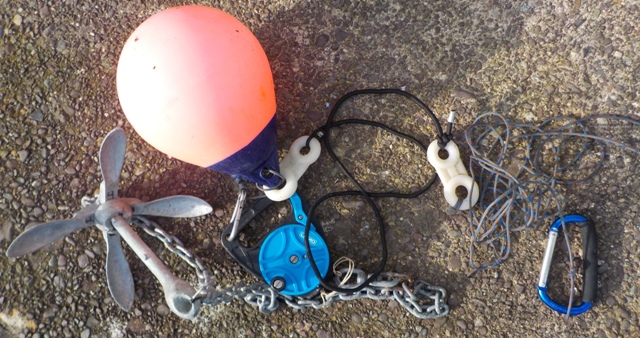
A typical anchor setup
Anchor
If you don’t have an anchor starting off don’t worry, there is a method to using one. Get used to paddling first and judging turns, distances, features etc. I’ll do a guide to anchoring soon.
I’ve added extra bungee to mine in the line between the buoy and the kayak.
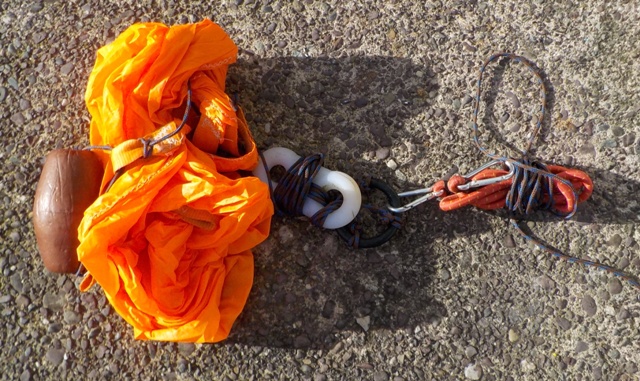
Drogue – Handy Item
Drogue
Similar to anchoring, get used to your vessel first before installing items that may look great but are useless if you can’t use them properly. A drogue is like a parachute for underwater – it slows you right down but still allows you to drift around, get your bearings etc. In an emergency it can be used to slow the drift of your kayak to give you time to sort yourself out.
I made my own, again thanks to Ian Harris. I also use the line and bungee for the drogue to tie the kayak to buoys.
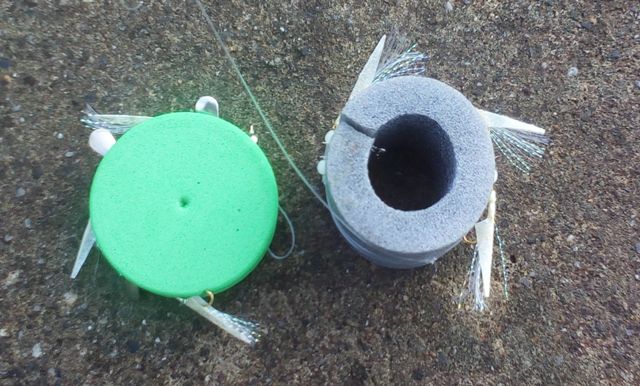
Keeping hooks tidy!
Useful Kit
Rig Winders
Very handy to organise your gear, you can make your own using heating pipe insulation or buy from your local tackle shop.
Chopping board
You really don’t want to cut your bait on the hull of the kayak.
Ceramic knife
Rust free, they hold a cutting edge. They are brittle, don’t bend them.
Tea towel or Rag
Great for cleaning your hands after handling bait or fish. Very useful for holding spiny fish such as the poisonousWeever.
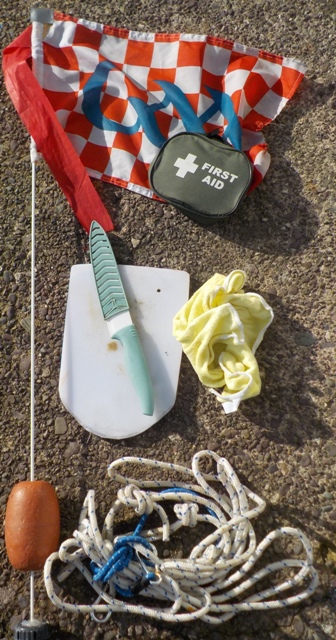
The Idiot Flag & Tow rope
Optional Kit
Fish Finder
Not sure how good mine is for finding fish! It is great for identifying features. I can use it to find a reef and to position myself where I want to be.
Spare Paddle
I carry one, most don’t.
Emergency Flotation
I’ve added >100l of flotation to the hull. The worse thing that can happen is that I get separated from the kayak. That is why I have my Phone, VHF & PLB tied to me. The next worst thing is that I have a leak I don’t know about. The flotation won’t allow me to paddle back to shore if I’m too far out, but a kayak is a bloody big target if someone is coming to rescue me.
Precautions and Planning
Check the Weather
Use several websites. There isn’t any point in me going into it when Jim Clohessy has written thisTopfisher.eu Weather – Go or No Go. As a rule of thumb I don’t launch in over 10 knots (11mph/19kph) unless I’m in an area where I can safely reachshelter under a headland or cliff.
Check the tide
Don’t just check high & low time, check the range (difference between high & low) as this is an indication of current speed. Check the charts as most have the Spring Tide Current. Ask locals or IKA members who have fished there before.
Tides Near Me will give tides for a week ahead and is also available as an android app.
Check the sea state
Have a look for webcams in the area. For Cork I useKite Sport Centre.
Check the current speed and direction
Look at “Local Tides and Tidal Streams” onIn Your Footsteps, you can change the location around the coast so find the one closest to where you launch.
Don’t plan a long trip where you’ll be paddling against a strong current on the way home. Google will tell you most people can comfortably manage 2-3 knots paddling speed.
As I explained to someone who was considering fishing where the current reaches 5 knots, 5 knots = 5.75 mph = 9.25kph.
Fall in at anchor & in 60 seconds you’re 155m or 510 feet from the Kayak.
Current speed versus the stage of the tide depends on location. It is not a case of saying at hours 3 & 4 of the tide the current is fastest. At slack water off coast you still have current in an estuary.
As a rule of thumb tide rises/falls:
1/12 of height first hour
2/12 second
3/12 third
3/12 fourth
2/12 fifth
1/12 sixth
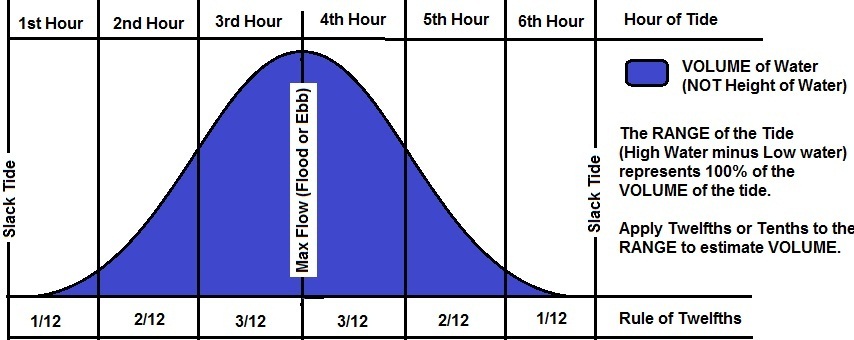
The Rule of 12ths
Paddle with others
I’m not going to be hypocritical as obviously I paddle on my own. When possible, paddle with others. Is travelling to a different venue really that big a deal?
Make sure someone knows
Aoife gets a text when I launch & another when I’m ashore.
Lessons Learned
As they say at work, if it’s not safe, don’t do it. Apply common sense. Stick within your comfort zone until you are ready to venture further out or to target species that may be troublesome on a kayak. Go back to shore if you don’t feel right or don’t like the conditions.

Respect The Water! Don’t just follow the crowd in search of fish. It doesn’t matter if the person you’re with wants to keep going. Every year kayakers are rescued because they pushed thing too far. Just because the person you are with has kayaked more doesn’t mean they have the correct for the sea and what it can do.
Always be ready to change the plan. Plenty of times I’ve hoped to kayak, found the forecast was wrong & left the kayak on the car. I’ve also had it rigged ready to go & reloaded it.
A wide kayak is a pig against the wind. There is a reason most IKA members recommend 13ft+. With the Ultra, I still have a kayak capable of carrying kids, or the dog, & going on family outings. If a mate offered me a brand new wide kayak free I’d tell him to give it to someone else.
Dress to swim, rig to roll. Hasn’t happened me yet but I know people who have lost a lot of gear.
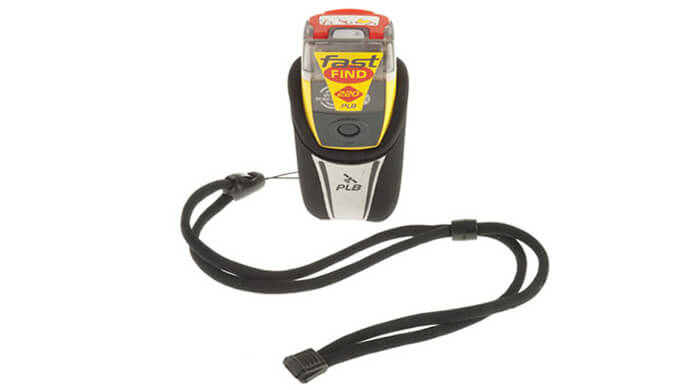
Personal Locator Beacon (PLB)
Bring more than one form of emergency communication. I had my phone in a pouch with a lanyard, got to the beach in Roche’s Point to find the phone & pouch were gone.
Vacuum pack yourself in your drysuit. I jumped off a pier, without my PFD, to wash off the fish smell. The air in the suit ended up at my feet & it was a struggle to keep my head above water.
Put on & zip your suit, put on your PFD. Pull the neck seal open, crouch down, most of the air will be pushed out. Or do the same thing while sitting up to your chest in water.
Support your local tackle shop. We all buy stuff online. We all buy stuff in our local shops when we need something quickly. Buy too much online & that Friday you need to pick something up, the shop may no longer be there.
Support your local kayak shop. See above.
Don’t bring the kitchen sink! I’ve had to throw away rigs that got wet and rusted in the original packaging. If you keep losing gear are you going to keep fishing? Do you really need 20 weights and that Tope trace you bought as a “just in case”?
Check how long the walk back is when the tide is out.

You’ll be tired before you start!
If you’re not confident to land where you launched find somewhere else. You can always walk back to the car.
If mackerel are about, more than one line in the water is a disaster. Especially when you have 4…
If you are species hunting, take advantage of summer evenings. Chasing species in November was cold!
If you are species hunting, target a species each trip. I was on the water 20 times in 2016, & most of the time hadn’t a clue what I was looking for, or how to catch it.
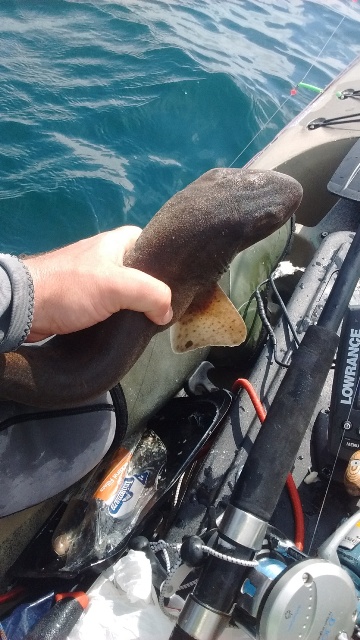
Inevitable when fishing with bait! Watch that pee!
Dogfish Urine is like a chemical burn. Wash it off straight away. Until Joe Lynch, skipper of Wreck Hunter explained, I’d only worried about their skin.
Fish small hooks & baits. It’s not just Pat Gill, Joe Stenning & Graham Smith – I stood next to David McCormick, Captain of the Irish Boat Team 2017 for a day. He was doing the same thing.
Fish simply.Ian Burtonis the King of Species Hunting.
Finally, go fishing ready to blank & you’ll never be disappointed with what you catch.
Tryouts & Training
Call to the IKA sponsors to arrange to tryout kayaking & training if you decide to go ahead.
Practice self rescue
There are plenty of videos on YouTube. If you plan fishing on your own & can’t get back in your kayak on your own, don’t fish on your own.
Practice assisted rescue
There are plenty of videos on YouTube. If you’re fishing with someone who can’t get back in on their own, you’ll have to help them in.
Learn how to use your VHF
You can’t ask for assistance if you don’t know how it works. There are many courses available all-round the country.
Learn how to use you PLB
You can’t ask for assistance if you don’t know how it works.
Useful Links
I do a lot of research before I make a trip so here’s everything I use.
Safety:
The RNLI
RNLI Kayaking and Canoeing& RNLI Respect The Water
Shore Marks:
All the shore marks on a map! Swords Angling Centre
Where to fish for different species try Inland Fisheries Ireland & Sea Angling Ireland
Location Guides:
Towards the bottom of page of Inland Fisheries Ireland & Inland Fisheries Ireland Publications
Species Identification:
Sea Angling Ireland & British Sea Fishing
Sea Fishing Rigs:
Planet Sea Fishing – Book Of Saltwater Rigs
When to catch which fish:
Irish Trophy Fish pick Fresh or Marine, find the fish you want, pick “Learn More”
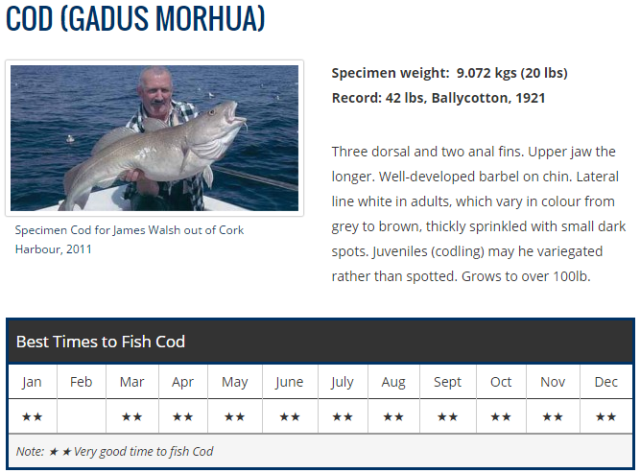
Research your target species!
Bait:
Check the shore mark descriptions at Inland Fisheries Ireland & Sea Angling Ireland. How to use it Sea Angling Ireland Book of Bait
Coast Views:
Check where you are launching and fishing at Coastal Helicopter View
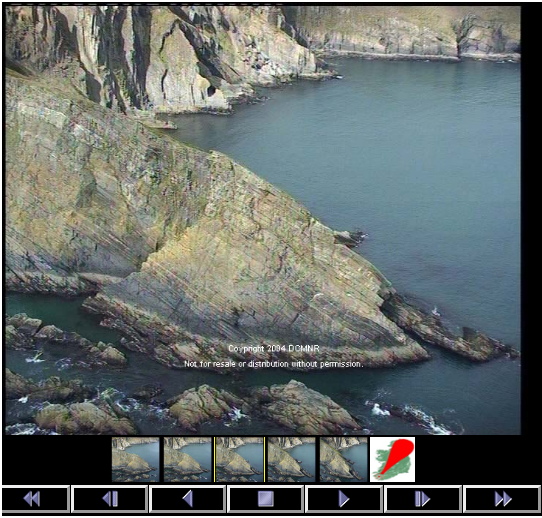
Coastal Helicopter view!
Aerial/Birds Eye Views:
Microsoft Bing Maps & Google Maps. In Google use the street view option to check parking, what beaches look like etc.
Ordnance Survey Maps:
OS Maps & aerial photos from 1995, 2000, 2005 are at Ordnance Survey Ireland. You would be surprised the difference of what you can see of the seabed between these & Google/Bing.
Live Sea State:
Charts/Water depths:
Navionics Charts are also available as a paid app. (R – Rock, S – S&, M – Mud, etc.)
Tides High & Low:
Tides for a week ahead Tides Near Me. Also available as a free phone app.
Tides Current Direction:
Check “Local Tides and Tidal Streams”at In Your Footsteps.
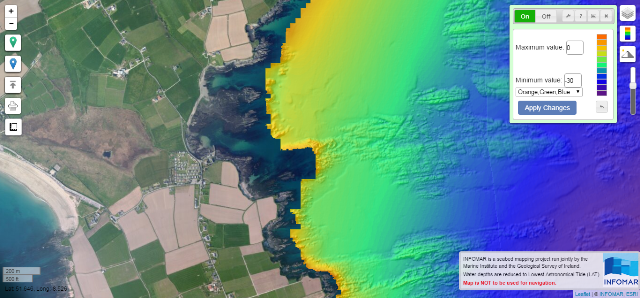
INFOMAR – An Incredible free resource!
Seabed profile:
The INtegrated Mapping FOr the Sustainable Development of Ireland’s MArine Resource INFOMAR. Mapping is not complete for the country but useful.
Finally
My obvious enthusiasm for the sport led to being elected as one of the moderators on the IKA forum. That does not mean that I am, or consider myself to be, an experienced kayak angler. I’m only at this game a year.
7 species on my first outing of 2017 is a promising start but I’m still learning. There are many more species I would like to land than I have landed and I’ve yet to try freshwater.
Hope it all helps you to enjoy your fishing and come home safe every day. Tight lines!
Tim
